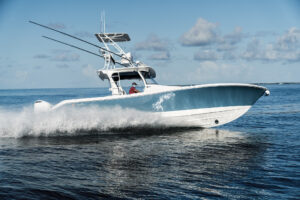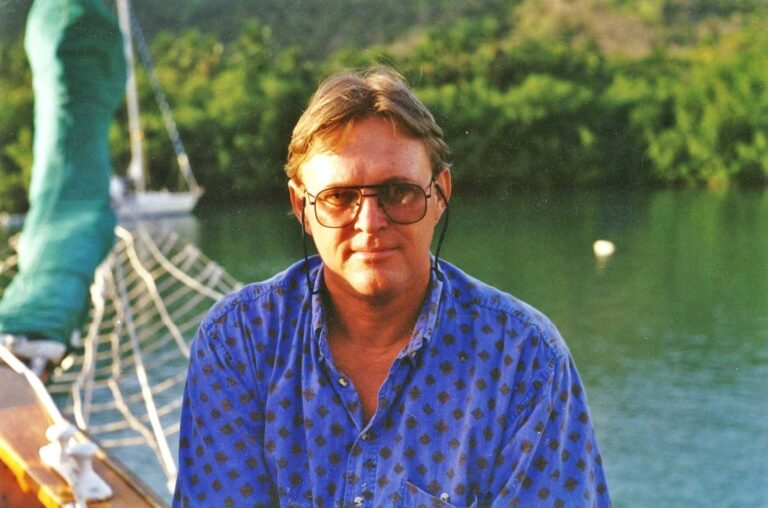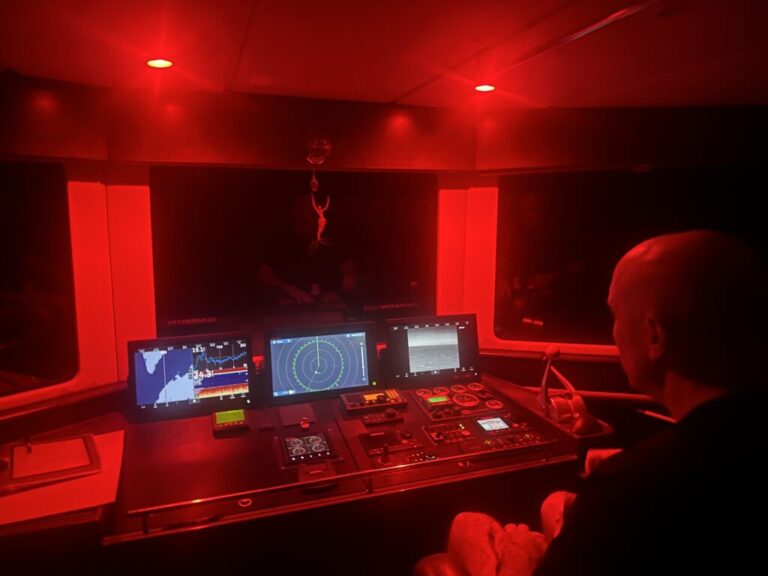An electric door slides open as a blast of air tinged with the smell of burning electricity hits me in the face. On the other side of the room, sparks fly as workers clad in silver suits pour white-hot, 3,000-degree molten stainless steel into ceramic molds. As the sparks settle, a door opens on an 1,800-degree oven that casts a red glow throughout the room. Another silver-suited worker pulls out a glowing-orange propeller mold with a clamp-like tool and then places it under the induction furnace as his colleagues repeat the pouring process.

The environment smells, feels and looks like the scene in the last “Lord of the Rings” movie when Frodo and Samwise suffer inside volcanic Mount Doom to try to destroy the One Ring. But unlike Mount Doom, the precision-controlled factory environment lacks the chaotic evilness of the fictional home of Lord Sauron. The precise nature of this place is critical, because it’s here, right in the middle of the Indiana manufacturing belt, where the 174 employees of Yamaha Marine’s Precision Propeller Inc. (YPPI) churn out as many as 60,000 outboard propellers every year. By the time each propeller reaches the shipping dock, it’s been touched by many hands—directly and indirectly—and looks like a beautiful sculpture, ready to make someone’s boating weekend a lot of fun.
Precision Propeller was started in 1969 in a two-car garage near the current factory site by owner and founder Jim Booe to provide propeller repairs and performance enhancements. By 1980, the outfit was rapidly expanding and producing a line of custom-made TURBO-branded propellers as well as building propellers for outboard manufacturers and private-label retailers and distributors. Yamaha Marine purchased the business in 2008.

Booe’s son, Chris, still works at the factory. “Things in the early days were done in an extremely ‘homemade’ fashion,” he says. “We made a lot of the equipment used to make the props ourselves, and our processes were very basic. Still, we had a great reputation for tuning up and crafting excellent props. Our TURBO propeller brand provided excellent performance, and our final fit-and-finish was stellar. The whole business was built on providing high-performance racing propellers.” The younger Booe works as the facility manager and as a process engineer.
Albert Duran, who today is a quality supervisor at the factory, was YPPI’s first wax room employee, charged with prepping the wax positives used in the investment casting process. “In the beginning we were happy if we made eight props a day,” he says. “It was a real home-brew operation back then. We used off-the-shelf items such as coffee cans and turkey roasters. Everything we do here today sprouted from that small two-car garage operation.”
The investment casting process YPPI uses, also referred to as lost-wax casting, is an ancient art that has been around for at least 5,000 years. The nuts and bolts of the process are essentially the same, but can be used to manufacture precision parts such as turbocharger impellers, turbine blades and, of course, propellers. Jonathon Burns, YPPI’s general manager, showed us through the factory and explained how Yamaha’s stainless-steel props are made, from start to finish.
“The first step is engineering the prop, which we do in collaboration with engineers in Japan and with two in-house engineers at the factory,” Burns says, as he shows us into an office. Huddled around a computer monitor are two engineers who are rotating a prop design around on the monitor in 3D. “We’re engineering the casting offset,” one says. “When the metal cools inside the mold, it shrinks, so when we design the molds, we need to account for that shrinkage, so the prop turns out exactly within specifications. People are surprised to know that the mold is actually larger than the finished prop.”

As we’re heading toward an area called the “wax room,” we walk between rows of metal shelves filled with hundreds of master patterns made from wood and automotive filler. “These are what we use to make the aluminum prop molds you’ll see inside the wax room. They’re based on the designs like the one we just saw in the engineering room,” Burns says. The door opens to the wax room, and I’m immediately hit with a smell sensation: Yankee Candle. This nicely air-conditioned and waxy smelling room (the chilly temps are used to keep the wax in the proper state) is where gigantic boxes of tiny, pink wax pellets are melted down and then injected into computer-controlled molds to produce complete hub and propeller blade positives, as well as separate hub and blade parts that are joined together by workers with skilled hands.
One such worker is Hilda Ramirez, who has been working at YPPI for 20 years. I meet her at her workstation, where she uses a soldering iron to precisely attach wax propeller blades to matching wax hubs. Once the blades are attached, she squirts a heated automotive goop (yes, “goop” is its actual name) at the points where the blades join the hub and then skillfully smooths them with a heated lead ball before scraping away any excess.
On the other side of the room, I meet Travis Cooper, who is monitoring an injection machine that makes wax “pour cups,” which are attached to the wax hub/blade assemblies and aid in the metal pouring process, acting as a funnel. They also provide a gripping point in the casting process. He makes about 205 to 220 of the cups each day. Cooper came to YPPI through a local high school program that places students with manufacturing skills in factory jobs around the area. “Welding is my trade,” Cooper says, “but I wanted to get started with a factory job to enhance my résumé and experience.” When the pour cup is ready, the two halves of the aluminum tooling automatically pull apart to reveal the part, which Cooper then inspects and places on a shelf behind him. The hubs and blades and complete hub/prop units are made the same way by different machines just a few feet away, manned by other factory workers.

As the wax molds make their way out of the wax room, they’re rolled on wheeled shelves to the “dip room.” Here the propeller molds are first bathed in a cleaning solution before being loaded up onto a platform where a robotic arm grabs them and then swirls them in different liquid slurries before holding them in a rotating drum that showers the mold with silica sand or zircon flour. It’s one of the few places inside the factory where I see robots being used. “We’ve found that this part of the process is one that can be greatly enhanced by the use of robotic technology,” Burns says. “There’s a preciseness to the dipping process that robots are just better at repeating over and over again.” I watch the mesmerizing robotic ballet as the dipping and sand coating process is repeated many times until a thick, yellow ceramic shell forms around the wax mold.
There’s more of that type of automation in YPPI’s future, a fact I learned the previous morning when I attended a groundbreaking for a new, state-of-the-art $18 million factory that YPPI will open in 2020 20 miles east in Greenfield, Illinois. “First, we want to be able to keep up with the high demand for propellers, both for our new outboards and aftermarket needs. It’s been a challenge keeping up with that demand over the last few years,” Burns said at the ceremony. “Second, we want to be able to build a facility where we can utilize the latest manufacturing equipment and processes to increase our output.”
The new facility also will allow YPPI to boost production by as much as 67 percent to more than 100,000 propellers annually. Lastly, Burns said, “We want the new facility to be a better place for our employees to work, a place where they have the absolute best tools and facilities to do their jobs. YPPI’s employees are the best in the business, and we want them to have a great place to go to work every day.”

Though that may make the existing factory sound awful, it isn’t. What I witnessed was that the operation is simply running out of room. Though each room was clean, well-organized and comfortable, it was obvious that workers spent a lot of time working around each other while wheeling carts about or simply doing their jobs at their workstations. In fact, the funniest and seemingly happiest people in the factory work in the most demanding, brutal area in the entire place: the foundry. It’s the next step in the prop-making process.
Once the ceramic coating has fully cured and dried—after spending time on wheeled racks being cooled in a bath of fan-driven air—the props make their way to the foundry. The first step inside the hot, steamy room involves placing the ceramic molds into an autoclave that bakes out the wax from inside the mold. Emptied of wax—which is recycled for later use—the ceramic molds are placed into a huge, 1,800-degree oven for an hour to fully set the ceramic shells and prepare them for pouring.
The current facility utilizes two small induction furnaces, which rely on electricity to heat and melt ingots of a special stainless-steel, nickel and chrome alloy called 15-5. One of the furnaces can hold 150 pounds of molten metal, while one on the other side of the room holds 65 pounds; the larger furnace can hold enough metal to produce four props a run, while the smaller one can do three.

While we’re standing outside the red zone, where everyone must be wearing protective silver gear, helmets, gloves, etc., I watch as technicians dip disposable probes into the molten metal. A digital thermometer reads 2,873, 2,880, then 2,900 before the probe is pulled out. “We pour between 2,975 degrees and 3,000 degrees,” says Burns as I try to wrap my head around what heat like that really means. Just then, a worker comes up to me and says, “If you get a drip of sweat in that pot, it will explode. We’re very, very careful around here,” he adds, chuckling. The whole group is approachable and easy to talk to, and we joke around while they are waiting for the metal to reach the right temperature. The probe goes in, the readout shows 2,982 degrees, and the silver suits step into action.
A worker on each side pulls out a glowing ceramic mold with a long, metal clamping tool, and then places it on a stand on top of a metal cart that rides on rails set into the floor, much like a miniature railroad. The molten metal pours so brightly that it’s difficult to look at with the naked eye. Once the mold is filled, the furnace is tipped back, a large, metal can is placed over the prop and the cart is wheeled back toward another part of the room. As my colleague Dan Harding and I don silver suits to get a feel for what it’s really like inside that baking-hot room, the whole team cheers and pumps their fists in the air. It’s obvious they are proud of what they do here.

Despite the skilled hands of these workers, plenty of things can go wrong in the pouring process. The metal cools so quickly that some of the metal is unable to make it all the way to the tips of the propeller mold. These voids are called non-fill. Some can be fixed later in the process, while others have to be scrapped and will be melted back into other propellers later. Inconsistencies introduced when the wax molds are being crafted can also result in scrap, though rough patches, holes and other defects can often be repaired later in the process. “That’s why those wax room folks are so important,” Burns says. “A sloppy shortcut in the wax room will result in someone having to fix the mistake down the line or the scrapping of the part.”
Once the casting cools, the detailed finishing process begins. First, in an area just behind the foundry, the metal-filled shells are placed in a machine that shakes the life out of them until the only thing left is the propeller, which looks surprisingly unfinished, having a rough, gunmetal-gray surface—nothing like the mirror-finish end product we saw earlier in the shipping area. Workers then cut off the pour cup with an industrial saw blade, while other members of the team use sand-blasting machines to remove bits of leftover ceramic materials from the detailed parts of the prop like the embossed Yamaha logo and propeller designation stamp. These folks, like the foundry workers, seem like unsung heroes of the process—this area is dusty and hot, and the props, still hot to the touch, arrive in a seemingly never-ending stream.

A two-minute walk across the parking lot lands us in the factory’s grinding area, where the propellers are further refined, and the artwork begins. Each part of the grinding operation is specific to a particular part of the propeller. Some workers use large, stationary belt sanders to hone the propeller blades, while others at small, private workstations use air-driven tools and small sanding pads to dress up propeller roots, logo areas and other nooks and crannies. There’s also a welding area here where pinholes, small voids and other defects are addressed.
Ahead of me in the next room are machines the size of asphalt layers and steam rollers, each fastened to the floor with massive bolts and fitted with immense springs at their bases. “We start out by vibrating the props in a ceramic media with aluminum oxide in it,” Burns says as he shows me a handful of the white, cone-shaped media that came out of a machine. “Next we use a couple of different types of drag polishers, which have a plastic media and arms that forcefully pull and swirl each propeller through the media until we have the exterior finish we’re looking for.”
Each propeller goes through a comprehensive measuring and quality control step—sometimes twice—to ensure it meets Yamaha’s performance specifications. Propellers are placed on a jig and fitted with micrometers and other measuring equipment as data is fed to a computer that tells the technician where adjustments need to be made. It feels as if we’ve gone back in time to the Iron Age as we watch a worker pound on a propeller with skillful, well-placed blows of his hammer. He takes it off the bench, fits it on the jig again, checks the measurements, and then starts making a few final adjustments with a smaller hammer.

Next, through yet another maze of doors we find banks of stationary belt sanders, tall carts with seemingly endless rows of propellers and a few workers grinding away in the background. One of the workers approaches us. “This is where we put a trailing-edge grind on each blade,” he says. “It’s a super important step, because this is what gives the propeller its bite.” He walks us over to his workstation and heavily leans the prop into the belt grinder as sparks fly. It looks easy enough, but this skill apparently takes a long time to learn. The gentleman who shows us his skills has been doing it for 20 years, and the way he works each prop definitely shows off the artistic aspects of finishing and completing a propeller.
Each propeller gets a final quality control check before making its way to the shipping department, where I find tables covered in props, paper towels and Windex. “These guys put the final shine on the prop before it goes in the box,” says Burns. “We sometimes joke that we’re shipping jewelry, but it’s important that each propeller looks perfect when the box is opened.”
That perfection is something that sticks with me all the way back home the next day. In that factory, it doesn’t matter whether you’re packing shipping boxes, pouring metal, grinding away defects or simply taking out the trash. The visit gave me an overwhelming feeling that everyone cares, and that they know their work makes a lot of boaters very, very happy. Longtime employee Albert Duran provides the best quote of the day: “We love what we do. We realize it brings a lot of pleasure to a lot of people. We rev hearts.”
This article originally appeared in the December 2019 issue.










